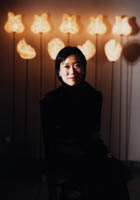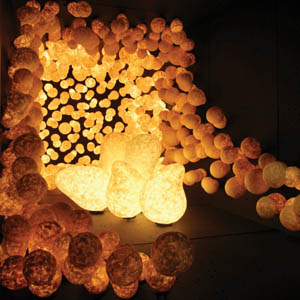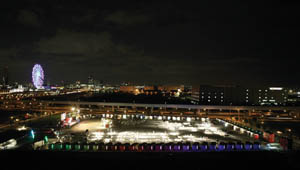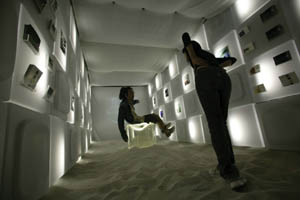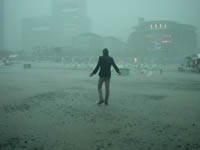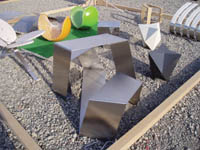Inspired by Imports
Back to Contents of Issue: March 2004
|
|
|
|
by Roland Kelts |
|
|
TOKYO DESIGNER'S WEEK (TDW) started modestly in 1997 as a way to wed aesthetic aspirations to functional need -- and there is no better place than Japan for the nuptials. As one festival organizer told me: "Look around you. Japanese life is full of limitations -- of space, of personality, of etiquette and behavior. Limitations are part of our culture. So we must find a way to make our needs into something beautiful. That's the unique challenge of art in Japan."
As with so much in Japan, the inspiration for the first TDW came from elsewhere -- specifically, a now defunct 70s-era New York event called "Furniture Saturday," wherein that city's furniture makers displayed their latest wares to aging hipsters looking to refurnish on a budget.
Last year's TDW went nonprofit and saw its own budget balloon. For the first time, exhibitions incorporated outdoor and indoor venues at several locations (no mean feat in super-vast Tokyo), with free shuttle buses, open discussions, parties and live music running throughout the five nights. The organizers set out to take on all of Japan -- or at least all of the country's creative centers -- with subsequent events in Osaka and Kyoto featuring international and local designers.
The centerpiece of it all was an attempt to build a futuristic city out of six-foot shipping containers trawled in from the nearby port of Yokohama. Design teams from Japan, Europe and the US were offered their own containers to fill with magic, movies or miasmas on an empty gravel lot in Odaiba, the massive artifical island built from landfill in Tokyo Bay. Artifice built upon artifice -- and torn down just as quickly as it appeared.
"Japan is a country built on imports; this is something specific to Japan," explains managing director Kenji Kawasaki. "We figured that using the containers would be a symbolic way to reflect on contemporary culture and rethink its purposes."
The result was somewhere between a Fassbinder fairground and a postmodern museum. Odaiba is about 40 minutes from anywhere in central Tokyo; you take a sky-tram to get there, passing over the sleek Rainbow bridge (featured in Quentin Tarantino's "Kill Bill"), and for the first time in this allegedly bayside city, you can actually smell and feel the saline seas.
Wouter Roeterink, a German designer, filled his container with an interactive game called the "Octopuzzle." Visitors sat down and performed the analog task of making design happen with bits of plastic and wooden boards. His first impression upon landing in Tokyo is revealing: "I thought: These containers are like the cockroaches of the world," Roeternik said. "If an A bomb blew away all those big buildings, the containers would remain."
Prize-winning students from 40 of Japan's finest design schools were selected to produce -- chairs! Nothing more functional, but nowhere less aesthetic: in open rectangular pits in the gravel sat places for sitting. "Suwaru Katachi: The Way We Sit" offered an interactive experience of the most mundane -- and magical. Visitors sipped glasses of wine and champagne as they perched atop oblong seats of steel or sunk into banana-shaped bronzes. The chairs provided a breather from the intensity of the containers. Yet like everything in Tokyo, the chairs themselves were part of the art. (Art and etiquette are intertwined in Tokyo: The way you handle your chopsticks can define you as an aesthete before you've taken a bite.)
"Actually, it's more than a temporary festival," Kawasaki confides. "We want the next generation to be nurtured here."
Government-sponsored Tokyo designers produced the Tokyo Wonder Site -- an extraordinary display of visionary talent in two containers, with two competing deejays ensconced atop each one, blaring funky beats in wicked polyrhythms. Inside their containers, bulbous, dismembered feminine bodies hung in space to evoke "the future of mannequins," according to one dude who smoked incessantly beside me, banging on a bongo. The eerie and vaguely grotesque collided with department store sterility. The bodies bore the colors of dimestore gumballs.
Eriko Horiki, an internationally celebrated washi artist, invited 400 primary school students to mold roundish washi lamps that light up in concentric curves, creating an elaborate whorl of light that suggested the illuminated interior of a human mouth or heart. Her washi lamps are meant to make your home or work space more organic. "Paper is a material which is a mixture of people, nature and technique," she says. "That is why Japanese use white paper to wrap money and gifts and put white paper underneath offerings for God. Kami (paper in Japanese) stands for spirituality, just as Kami also means God."
Fredrik Cederroth, a designer with Stockholm Design Lab in Sweden, sums up the appeal of Japan as a home for your future -- and mine: "Japan lacks the orthodox opinions concerning good taste," he says. "In Europe, the design elite decides upon what is good taste, and deviations from this norm are rare. Japan has a liberal attitude toward both design and architecture. They are not yet locked up in what many Europeans mean when they say 'good taste' -- which tends to become a prison for creative people."
@
Tokyo designer Eriko Horiki created a new kind of internal lighting -- blending the sensual with the spatially erotic: "For this piece, I held a workshop for elementary school students, who will be our future designers. In the beginning, they were hesitant to touch the gluey raw material. But no one gave up, and in the process we all started having fun. With the hope that human beings and nature can coexist in harmony in the future, we created lamps based on the image of an echo (the spirit of a tree), and filled our containers to purify the air inside, like you would a home."
"What we want to do is create an artificial city upon an artificial city. We put containers on an artificial island in Tokyo -- the most artificial city in the world." -- Tokyo Designer's Week managing director, Kenji Kawasaki.
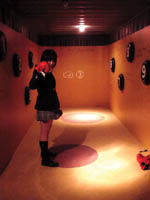
Dutch design team Wouter made telephone calls physical -- calling upon the violence of contemporary communications: "It was great to see how the usually so shy Japanese were letting themselves go loose, boxing like madmen on the telephone buttons. Especially girls. It also occurred to me how few people are familiar with overseas calling. It would actually be great if we could place it in downtown New York. But Tokyo is different from other places I know because this city is practically deprived of design. We are coming from a country (The Netherlands) where every square millimeter is designed. It's design overkill. Being in Tokyo is quite liberating in that sense. Maybe it has to do with being Dutch, I'm not sure, but we miss the playfulness in design. Everything is so bloody serious here. Let's play, people! And talk!"
The Kotobuki design team make chairs out of glass: "We hope our guests experienced the relationship between their own body shapes and new chairs. Kotobuki has been producing furniture for public use, especially chairs. Chairs are used casually but should reflect our bodies and their movements. This is our goal: Through a fun experience, visitors to our site may become aware of the complex sense of design in what we consider casual furniture."
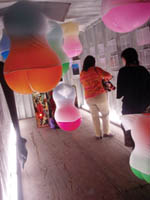
Tokyo Wonder Site, a design collective financed by the Japanese government, set out to create the mannequins of the future. Eerily hung from the ceiling, the bulbous -- and legless -- feminine physiques had the levity and heft of Christmas ornaments. An open chest of chic clothing stood open on one end of the container, and mesmerizing texts adorned the walls. "Our work is rather analog in style, but the people who came into contact with it and felt it (in their hearts, if not physically) all had smiles on their faces," says one of the chief designers. "It made me happy to think they were seeing a new world from our perspective. Tokyo remains an 'experimental' place. Compared to Tokyo, cities like Paris and New York share a mutual and conscious admiration toward each other, and I feel that that is creating one 'color,' or atmosphere, for those cities. Tokyo keeps the observer on edge. Culture here is intermittent, and things that are brought in all bustle about in their own arbitrary ways. Tokyo's color shows in the way that it doesn't have one."
One of the challenges of the event -- and a key to its meaning -- was keeping it open to the elements in Tokyo Bay
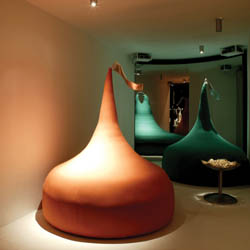
Corporate sponsors were very much a part of the event -- but with an unusual dose of charm. Japanese designers Super Robots were charged with creating a Hershey's container. "Hershey is not that popular in Japan," says 30-year-old Keiji Ashizawa, one of three youthful designers on the team. "So we really wanted to make this appealing and simple. We thought the kisses as chairs would be consistent with the theme of the show. And the chairs would be sophisticated, so adults could nibble on the chocolates in comfort. What a way to live!" Superimposed on the walls were images of war and peace -- soldiers and activists. "We wanted to remind visitors that chocolate is both a fantasy and a real food. And that the real world is also a part of chocolate." (left): French automakers Peugeot presented their design team with a novel challenge: Create a container that somehow embodies the sensation of driving Peugeot's latest models -- without showing the cars themselves. The resulting space was like a metaphysical highway, smooth and pristine, its borders lined with grass. At the end of the road stood the Peugeot lion bathed in rich blue, its body opening up onto a kaleidoscopic display. The pastel-hued "windows" along the highway contained three-dimensional dioramas to peer in upon. The mix of voyeurism with a sense of movement made for a seductive experience. "It is soothing," noted one Tokyoite standing beside me. "But I think it's about the way driving should be. Not the way it really is." Not in Tokyo, anyway.
Tokyo design students worked on chairs of the future. Forty were selected from the best of the city's design schools. "The Way We Sit" was the name of the outdoor exhibition, which many designers considered pivotal to the spirit of the event. "None of this is commercial. It's just expanding our horizons," notes Fredrik Cederroth of Stockholm Design Lab AB. "That's what makes it essential. It's learning how to sit all over again."
|
|
Note: The function "email this page" is currently not supported for this page.


